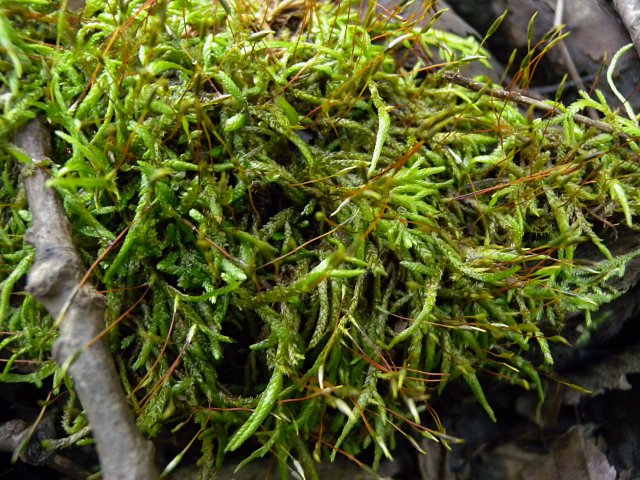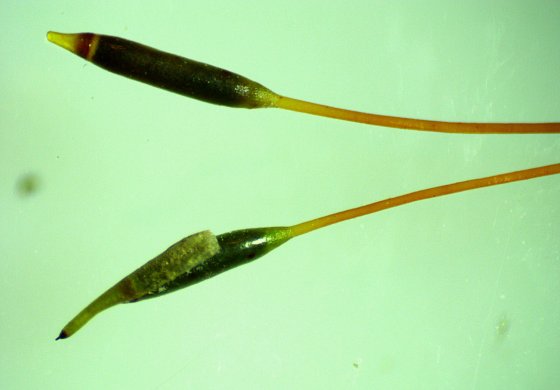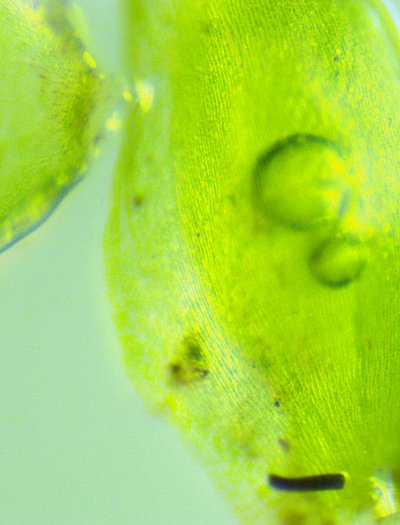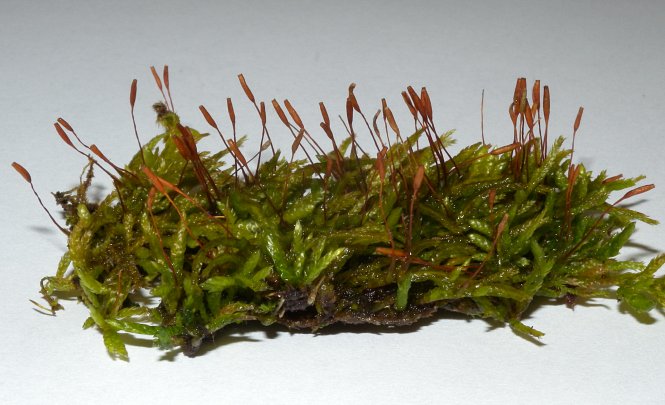
This moss is monoecious, forming male and female reproductive organs on the same plant. After fertilization occurs, solitary spore-bearing capsules on slender stalks (setae) are produced at intervals along the stems (except at their tips). The stalks are 7-20 mm. long, terete, hairless, and ascending to erect. Depending on their maturity, the stalks are light green, light yellow, orange, or red. The spore-bearing capsules are held erect at the apices of their stalks. These capsules are 2-3 mm. long, hairless, and either narrowly cylindrical or narrowly cylindrical and slightly ovoid in shape. The bases of these capsules are somewhat tapered, while their tips have long-beaked lids. The beaks of the lids are straight and erect, straight and slightly tilted to one side, or erect and slightly curved. The bodies and lids of these capsules are medium to dark green while immature, but they later become orange at maturity (or less often, red). Immediately below the lid of a capsule, there is a conspicuous ring of cells (an annulus) that tends to be yellowish. The beak and upper body of the capsule is covered by a beaked hood (calyptra); this hood is membranous, hairless, and early-deciduous. During the autumn, the lids of the capsules fall off and the tiny spores are released to the wind.

When a lid falls off a capsule, a ring of 16 slightly incurved teeth (the peristome) is revealed. These teeth are linear-lanceolate in shape and initially reddish; their sides are minutely bumpy. There is also an inner ring of 16 teeth (the endostome). These inner teeth are linear in shape, somewhat smooth to minutely bumpy along their sides, and initially yellowish. These teeth regulate the release of the spores. The spores are 12-20 micrometers across, globoid in shape, and slightly roughened or minutely bumpy (papillose). Brownish rhizoids develop at intervals along the stems to anchor this moss to the substrate; they are fibrous and brownish. This moss normally occurs in mat-like colonies of varying size. It can spread asexually to new areas when its leafy stems break off as a result of strong wind or other disturbance.
Cultivation: The preference is dappled sunlight from autumn to spring and light to medium shade during the summer. Moist humid conditions are preferred, although this moss also tolerates drier conditions in shade and/or during cool weather. The preferred substrate is a fallen rotting log or fallen rotting branches, although it also adapts to ground soil and the lower trunks of trees. This moss is somewhat weedy and it has a tendency to spread.

Range & Habitat: The Flat Glaze Moss (Entodon cladorrhizans) is common in Illinois, where it is native (see Distribution Map). This moss has been collected from most areas of the state; it probably occurs in every county. Flat Glaze Moss is widely distributed in the eastern half of the United States and adjacent areas of Canada. Habitats include decaying logs in woods (especially near streams and pools of water), fallen branches in woods, tree stumps in woods, exposed ground soil in woods (especially along exposed banks), logs and shaded ground in swamps, clay banks of ravines in woods, ground soil and logs along wooded hillsides, lower trunks of deciduous trees, gullies in hilly woodlands, ground soil of railroad prairies, exposed ground along the north walls of buildings, and old limestone blocks in shade. This moss occurs in both high quality natural areas and disturbed areas. In particular, it thrives in disturbed wooded areas where deciduous trees are dominant.

Faunal Associations: The Least Flycatcher, Slate-colored Junco, and probably other songbirds use this moss in the construction of bird nests (Breil & Moyle, 1976). Sometimes birds break off leafy stems of this moss while hunting for insects and other invertebrates. In open areas, these broken-off stems can be blown about in the wind to colonize new areas. Human- and squirrel-related activities may also dislodge this moss from the ground, achieving the same effect.
Photographic Location: Fallen rotting branches in a wet gully along a wooded hillside in Champaign County, Illinois. Close-up photographs were taken indoors using a microscope.

Comments: Flat Glaze Moss (Entodon cladorrhizans) presents a rather chaotic and intertwining appearance as it sprawls across either wood or the ground. Many of the leafy stems are not attached to the substrate as they clamber over adjacent leafy stems, creating a rather loose mat that is easy to pull and dislodge. This characteristic is not uncommon among pleurocarpous (mat-forming) mosses. Flat Glaze Moss and Round Glaze Moss (Entodon seductrix) are the only two moss species in this genus that are common in Illinois. About 3 other species exist within the state, but they are rarely encountered. Whereas the leafy stems of Flat Glaze Moss are somewhat flattened, the leafy stems of Round Glaze Moss are terete (circular in cross-section). Otherwise, they are very similar to each other in appearance. One of the uncommon moss species in this genus, Entodon challengeri (syn. Entodon compressus), is very similar in appearance to the preceding two moss species, except its leafy stems are strongly flattened. In addition, the spore-bearing capsules of this latter moss are shorter in length (1.5–2 mm.) and they have a slightly more swollen shape (narrowly ovoid-cylindrical) than the spore-bearing capsules of Flat Glaze Moss.